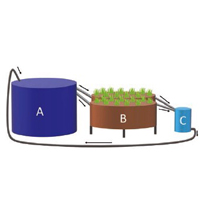Nitrogen budget in recirculating aquaponic systems with different fish stocking density

Accepted: 2 July 2020
HTML: 139
All claims expressed in this article are solely those of the authors and do not necessarily represent those of their affiliated organizations, or those of the publisher, the editors and the reviewers. Any product that may be evaluated in this article or claim that may be made by its manufacturer is not guaranteed or endorsed by the publisher.
As in any agroecosystem, also in aquaponics the nitrogen (N) balance represents an important tool to evaluate sustainability, and to identify factors that can improve N use efficiency (NUE) and reduce N losses. In this respect, fish stocking density has been little investigated, hence this research aimed to evaluate the N balance of a low technology aquaponic (AP) system managed at two fish densities in comparison with a hydroponic system (HP). In the fish tanks common carp at two initial stocking densities were reared (2.5 and 4.6 kg m–3 in low and high AP, hereafter named APL and APH, respectively) and the vegetated sector was cultivated with a leafy vegetable crop succession (Catalogna chicory, lettuce, Swiss chard). The N balance considered N input as fish feed or fertiliser, and N content in the initial water and the N output as N in the incremented fish biomass, in the harvested vegetables, in the sediments, and in the remaining water. Total N loss was estimated by difference. The total N input and the N loss through gas emission in the atmosphere were much higher in AP than in HP, particularly at high stocking density. The opposite trend was observed for the N input recovered in vegetable aboveground biomass. The N input recovered as fish biomass was slightly higher in APL compared to APH. The better results of APL than APH suggest that in low-tech AP system lower initial fish density should be adopted at the system start up to maximise both production and N recovery.
Highlights
- The higher initial fish density had higher N input, but resulted in a lower N recovered in fish and vegetable biomass, and much higher N loss as gas emissions.
- The lower initial fish density combined a lower N input to a higher recovery in fish and vegetable biomass, and a lower N loss as gas emissions.
- The lower initial fish density allowed to maximise both production and environmental preservation.
How to Cite
PAGEPress has chosen to apply the Creative Commons Attribution NonCommercial 4.0 International License (CC BY-NC 4.0) to all manuscripts to be published.

 https://doi.org/10.4081/ija.2020.1639
https://doi.org/10.4081/ija.2020.1639



